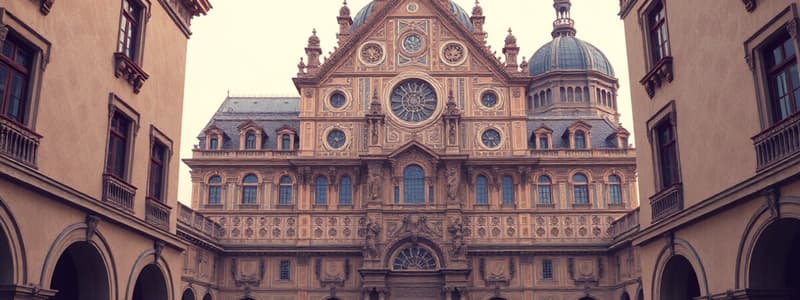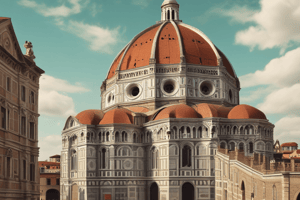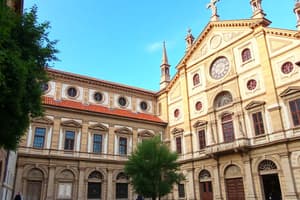Podcast
Questions and Answers
Which artist is recognized as the oldest among the founding fathers of Renaissance architects?
Which artist is recognized as the oldest among the founding fathers of Renaissance architects?
- Leonardo da Vinci
- Filippo Brunelleschi (correct)
- Donato Bramante
- Donatello
What type of architecture does the Tempietto by Donato Bramante signify?
What type of architecture does the Tempietto by Donato Bramante signify?
- Revival of ancient Roman architecture (correct)
- Modernist architecture
- Baroque architecture
- Gothic architecture
What is a key characteristic of vaults in Renaissance architecture compared to Gothic vaults?
What is a key characteristic of vaults in Renaissance architecture compared to Gothic vaults?
- They are built on a square plan (correct)
- They utilize pointed arches
- They often have ribs
- They are frequently rectangular
Which of the following works is Leonardo da Vinci best known for?
Which of the following works is Leonardo da Vinci best known for?
What was the primary purpose of pointed arches in architecture?
What was the primary purpose of pointed arches in architecture?
What is a distinctive feature of windows in Renaissance architecture?
What is a distinctive feature of windows in Renaissance architecture?
What is a common feature of the façades in Renaissance religious architecture?
What is a common feature of the façades in Renaissance religious architecture?
Which building designed by Michelozzo di Bartolomeo is significant in early Renaissance architecture?
Which building designed by Michelozzo di Bartolomeo is significant in early Renaissance architecture?
Which characteristic is commonly associated with Centralized Plans in Renaissance architecture?
Which characteristic is commonly associated with Centralized Plans in Renaissance architecture?
Which structural feature involves an inclined bar that extends from a wall to a distant pier?
Which structural feature involves an inclined bar that extends from a wall to a distant pier?
Which architect is recognized to be the first modern engineer, planner, and construction supervisor?
Which architect is recognized to be the first modern engineer, planner, and construction supervisor?
Renaissance architecture is characterized by a rejection of which Gothic style elements?
Renaissance architecture is characterized by a rejection of which Gothic style elements?
Which characteristic distinguishes the arches used by Alberti in his monumental structures?
Which characteristic distinguishes the arches used by Alberti in his monumental structures?
Which term describes the design elements that provide structural stability while also enhancing aesthetics?
Which term describes the design elements that provide structural stability while also enhancing aesthetics?
What time period does the High Renaissance cover?
What time period does the High Renaissance cover?
What was a significant effect of introducing large stained-glass windows in Gothic architecture?
What was a significant effect of introducing large stained-glass windows in Gothic architecture?
Which of the following best describes the structural foundation of Renaissance architecture?
Which of the following best describes the structural foundation of Renaissance architecture?
What aspect of Renaissance architecture reflects the recovery of classical elements?
What aspect of Renaissance architecture reflects the recovery of classical elements?
In what historical context did the Renaissance architecture first develop?
In what historical context did the Renaissance architecture first develop?
What is one of Brunelleschi's significant contributions to architecture during the Early Renaissance?
What is one of Brunelleschi's significant contributions to architecture during the Early Renaissance?
Which architect is considered one of the founding fathers of the Renaissance and is known for designing the octagonal brick dome of Florence?
Which architect is considered one of the founding fathers of the Renaissance and is known for designing the octagonal brick dome of Florence?
Which approach did Leon Battista Alberti promote in his architectural theories?
Which approach did Leon Battista Alberti promote in his architectural theories?
What was a common source of inspiration for Renaissance architects like Brunelleschi?
What was a common source of inspiration for Renaissance architects like Brunelleschi?
What is a defining feature of the High Renaissance period in architecture?
What is a defining feature of the High Renaissance period in architecture?
Flashcards are hidden until you start studying
Study Notes
Renaissance Architecture
- The Renaissance was a period of rebirth for art, architecture, and literature in Europe, particularly in Italy.
- The Renaissance style saw the revival of ancient Roman architectural styles and the rise of great architects.
Early Renaissance Architecture
- Early Renaissance architecture (also known as the Quattrocento) took place between 1400–1500 in Italy, especially Florence.
- Architects of the Early Renaissance focused on simplicity and balance, returning to the Roman models of architecture.
- Key architects of the Early Renaissance include Filippo Brunelleschi, Leon Battista Alberti, and Michelozzo di Bartolomeo.
- Palazzo Medici Riccardi, designed by Michelozzo di Bartolomeo, is considered a prime example of Early Renaissance architecture.
Filippo Brunelleschi
- The most famous architect of the Early Renaissance, Brunelleschi was primarily focused on church design.
- His most recognized work is the octagonal brick dome of Florence Basilica, an architectural masterpiece.
- The reconstruction of Florence’s ancient cathedral, which took place during the Early Renaissance, became a symbol of the era.
Leon Battista Alberti
- A leading architect of the Early Renaissance, Alberti was a key figure in the development of architectural theory.
- He emphasized the adaptation of ancient classical forms for modern buildings.
- One of his most famous works is the San Andrea church in Mantua, where he famously utilizes the arch on a monumental scale.
Michelozzo di Bartolomeo
- Michelozzo was another architect who worked under the patronage of the Medici family.
- His most famous work is the Palazzo Medici Riccardi, commissioned by Cosimo de' Medici in 1444.
Building Components of Renaissance Religious Architecture
- Vaults in Renaissance religious architecture lack ribs and are semi-circular or segmental.
- Windows are often paired and set within a semi-circular arch, with square lintels and triangular or segmental pediments.
- Centralized plans, with a square, symmetrical appearance, are characteristic of Renaissance buildings.
- The module, often the width of an aisle in a church, is a key element in establishing proportions within the building.
The Tempietto
- Designed by Donato Bramante, the Tempietto is a revival of ancient Roman commemorative architecture.
- This circular temple is constructed from bearing masonry and features a classical entablature.
Renaissance Characteristics
- Renaissance architects strived for clarity, balance, and proportion in their designs.
- The use of classical Roman elements like arches, columns, and pediments returned to popularity.
- The writings of Vitruvius, a Roman architect, became a major influence on Renaissance architecture.
Donato di Niccolò di Betto Bardi (Donatello)
- A sculptor of the Early Renaissance, Donatello is best known for his work "Saint Mark."
- He is a crucial figure in the transition from the Middle Ages to the Renaissance.
### Centralized Plans
- Centralized plans were a key innovation of the Early Renaissance.
- These plans were based on a symmetrical configuration with a central point, representing a shift away from Gothic architecture.
- The Temple of the Holy Sepulcher was a key inspiration for centralized plans.
Most Important Renaissance Artists
- Leonardo da Vinci was perhaps the best-known Renaissance artist, famed for his works like the "Mona Lisa" and the "Last Supper.”
- Da Vinci was not only an artist but also an inventor, scientist, architect, and engineer.
Pointed Arches
- Pointed arches, a feature of Gothic architecture, were adopted by Islamic architecture.
- These arches contributed to relieving the weight of the roof structure.
Ribbed Vaults
- Ribbed vaults, another characteristic of Gothic architecture, helped support the weight of the roof.
- These vaults used ribs to transfer the weight to the supporting piers.
Flying Buttresses
- Flying buttresses, developed during the Gothic period, functioned as supports and served to counter the thrust of a roof or vault.
- These impressive structural elements are made from masonry and extend from the upper part of a wall to a distant pier.
Rose and Stained Glass Windows
- Rose and Stained Glass Windows were popular adornments of Gothic cathedrals.
- These windows served as visual storytelling elements, enriching the architectural design with light and color.
Piers
- Piers, large structural columns, played a crucial role in supporting the weight of vaulted ceilings in Gothic architecture. Their massiveness was masked by decorative colonnettes.
- Gothic piers were also designed to accommodate the lateral forces generated by vaulted ceilings.
Spires
- Spires were a distinctive feature of Gothic architecture.
- These towering vertical elements, typically found at the tops of towers, added grandeur and height to the buildings.
- Spires often served as the focal point of a cathedral or church, representing aspiration and spirituality.
Axiality and Symmetry
- Axiality, a principle of design that refers to a central axis, and symmetry, the mirror-like reflection across an axis, were key elements in Gothic architecture.
- This emphasis on balance and order was evident in the layout of Gothic buildings.
Structural Based Architecture
- Gothic architecture was characterized as a structurally based style, prioritizing form and function.
- The architectural elements were carefully designed to distribute and support the weight of the structure.
Lightness and Darkness
- Gothic cathedrals were designed to incorporate light and darkness as expressive elements.
- Employing tall stained glass windows, architects created an interplay of light and shadow within the building, adding a sense of mystery and awe.
Vertical Perception of Space
- Gothic architecture aimed to create a sense of verticality and upward reaching aspiration.
- Through towering heights, pointed arches, and soaring spires, the buildings evoked a sense of grandeur, reaching towards the heavens.
Gargoyles
- Gargoyles were decorative, grotesque figures that served a functional role in Gothic architecture.
- They acted as water spouts, channeling rainwater away from the roofs and walls.
Scale
- Gothic cathedrals were monumental in scale, reflecting the ambition and grandeur of the era.
- Their massive size, intricate details, and soaring heights conveyed a sense of awe and wonder.
Studying That Suits You
Use AI to generate personalized quizzes and flashcards to suit your learning preferences.




